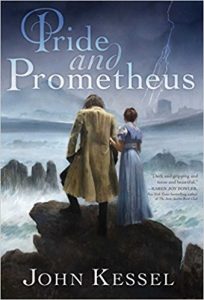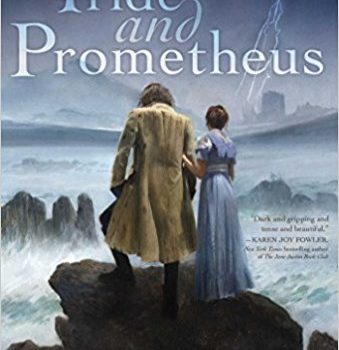Russell Letson Reviews Pride and Prometheus by John Kessel
 Pride and Prometheus, John Kessel (Saga 978-1-5344-1121-0, $27.99, 371pp, hc) February 2018. Cover by Robert Hunt.
Pride and Prometheus, John Kessel (Saga 978-1-5344-1121-0, $27.99, 371pp, hc) February 2018. Cover by Robert Hunt.
In my 2017 wrap-up essay elsewhere in this issue, I wonder at and wander around the matter of sequels, prequels, series, and common-background-setting books. All these present particular challenges to a reviewer: how to deal with a work that may begin in medias res (or, god-help-us, on the far side of a cliff-hanger), or that requires tippy toeing around spoiler-booby-trapped antecedent action, or that simply demands more explanatory setup than a stand-alone novel. Both of this month’s books present variations on this challenge, though only one is a part of a series in the usual sense.
What John Kessel has done in Pride and Prometheus is trickier than constructing a giant secondary universe or devising a protagonist who can sustain adventures across multiple volumes. Pride and Prometheus is inserted into the gaps between Pride and Prejudice and Frankenstein, bridging not only their imagined worlds but their literary genres and sensibilities. In devising a framework in which Lizzie Bennet’s younger sister Mary meets Victor Frankenstein and his Creature, Kessel has taken on a project much more ambitious than the last few years’ worth of Jane-Austen-based romances or Lizzie-and-friends period-piece murder mysteries – it is an attempt to yoke together the social vision of Austen and the gothic proto-SF of Mary Shelley, to see what kinds of fields can be plowed with those beasts. (Yeah, yeah, Pride and Prejudice and Zombies, except this book isn’t a funny-once stunt.)
The rule that Kessel has accepted is that his story cannot change the elements of either Pride and Prejudice or Frankenstein; or The Modern Prometheus, beyond a bit of fiddling with dates to allow the story to take place at all. Setting it 13 years after the end of Pride and Prejudice also allows time for Mary Bennet to grow beyond the naive, earnest girl she had been at 19 – though she is still recognizably “the Bennets’ tall, left-handed, wrong-footed daughter [who] had long been assigned, in the minds of society, the role of old maid.” At 32, her intellectual interests are focused on natural philosophy and the examination of fossils, and while she is mostly resigned to spinsterhood, she knows that there is hope for her still-beautiful and -marriageable younger sister Kitty. For nearly half the book, then, her chapters are largely concerned with efforts to improve Kitty’s prospects as her own dwindle.
But this is not only Mary’s story, and her third-person chapters sit next to the first-person accounts of Victor and the Creature. The latter we meet as he tracks Victor from the Continent to England, where he intends to enforce his demand that Frankenstein create for him a companion, a woman. Mary and Victor meet, not cute but quite seriously, at a ball, where they discuss topics such as the work of chemist Humphrey Davy and (rather indecorously) the murder of Victor’s young brother. What Mary does not know is that the Creature who killed the boy is lurking outside the ballroom. She will eventually come to hear both his and Victor’s versions of backstory events, while playing a crucial part in the hidden story that Shelley did not tell.
Mary’s chapters allow the book its greatest freedom of maneuver, since her history after Pride and Prejudice is open, however predictable it might have been in a non-gothic universe. And by seeing her character – or, to be precise, her personality – through the filters of modern psychology, Austen’s portrait of her can be sympathetically reframed. Her social awkwardness, her difficulty in reading people, and her dependence on worked-out rules and procedures all mark her as a familiar modern type. That does not make her into a textbook “on the spectrum” cartoon. She has carefully and gradually put together a picture of herself and her place in the world, and achieved a hard-won realism about the condition of women. In discussing marriage prospects with Kitty, who longs for a “kindred soul” such as Lizzie has found, she says, “I fear you shall find it easier to get the man with ten thousand a year.” She already knows that her own sole possible suitor, Mr. Woodleigh, with his conventional pronouncements and lips “pursed… like a fish,” is not for her.
Victor and the Creature, however, are caught in unalterable mid-trajectory, and the fates decreed for them by Shelley limit what can be done with them here. The Creature is driven by rage at Victor and disgust at humankind, but Mary also sees him as an alienated looker-in at the happiness of others, desperate for love and acceptance. In a speech that echoes Kitty’s, he declares that he longs for “a companion for my loneliness, a sympathetic soul who might comfort me, and whom I would dedicate myself to making happy.” He is highly intelligent and analytical, and his view of human society has an outsider’s clarity. For example, he sees Darcy as “a product of the world that had invented property only to divide and hoard it, the world of immense wealth and squalid poverty, of rank, descent, and noble blood.” Even Mary, who finds the courage to face him and engage him in debate, is only “a privileged, idle woman who could not see beyond the cage that society had fashioned for her.”
For his part, Victor is trapped between guilty self-loathing and the Promethean ambition that never entirely leaves him. And despite Mary’s account of the Creature’s misery, he can see his creation only as a monster whose “wretchedness is a mere mask…. He is the vilest creature that has ever walked this earth. He has no conscience, no soul.”
Any book that takes on the Matter of Austen is going to be measured against that formidable body of prose, that nuanced and ironic voice. Kessel manages the challenge by not pushing for a false archaism, though the book does begin with the practically-obligatory homage to the opening of Pride and Prejudice: “At the age of nineteen, Miss Mary Bennet had believed three things that were not true.” But thereafter the text does not strain to mimic either Austen’s or Shelley’s style. Nor does the story follow the rather complicated frame/epistolary structure of Frankenstein, opting instead for converging lines that provide the dramatic and thematic payoff. The result is a set of perspectives: Victor and the Creature as seen by Mary; Mary as seen by the Creature; the Creature as seen by Victor; the ordinary world of 1815 as seen by Mary and the Creature. It’s a nicely elaborated dance of viewpoints, of sensibilities, of ironies, and of genre conventions and tropes. At the end, Victor and the Creature exit in the direction of their appointed final confrontation, and Mary eventually finds a landing-place of her own, enlarged but not utterly transformed by her experiences. And nary a zombie or sea monster in sight.
Russell Letson, Contributing Editor, is a not-quite-retired freelance writer living in St. Cloud, Minnesota. He has been loitering around the SF world since childhood and been writing about it since his long-ago grad school days. In between, he published a good bit of business-technology and music journalism. He is still working on a book about Hawaiian slack key guitar.
This review and more like it in the February 2018 issue of Locus.






